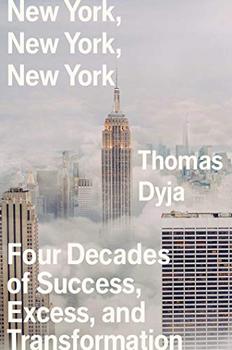
Four Decades of Success, Excess, and Transformation
by Thomas Dyja
A lively, immersive history by an award-winning urbanist of New York City's transformation, and the lessons it offers for the city's future.
Dangerous, filthy, and falling apart, garbage piled on its streets and entire neighborhoods reduced to rubble; New York's terrifying, if liberating, state of nature in 1978 also made it the capital of American culture. Over the next thirty-plus years, though, it became a different place—kinder and meaner, richer and poorer, more like America and less like what it had always been.
New York, New York, New York, Thomas Dyja's sweeping account of this metamorphosis, shows it wasn't the work of a single policy, mastermind, or economic theory, nor was it a morality tale of gentrification or crime. Instead, three New Yorks evolved in turn. After brutal retrenchment came the dazzling Koch Renaissance and the Dinkins years that left the city's liberal traditions battered but laid the foundation for the safe streets and dotcom excess of Giuliani's Reformation in the '90s. Then the planes hit on 9/11. The shaky city handed itself over to Bloomberg who merged City Hall into his personal empire, launching its Reimagination. From Hip Hop crews to Wall Street bankers, D.V. to Jay-Z, Dyja weaves New Yorkers famous, infamous, and unknown—Yuppies, hipsters, tech nerds, and artists; community organizers and the immigrants who made this a truly global place—into a narrative of a city creating ways of life that would ultimately change cities everywhere.
With great success, though, came grave mistakes. The urbanism that reclaimed public space became a means of control, the police who made streets safe became an occupying army, technology went from a means to the end. Now, as anxiety fills New Yorker's hearts and empties its public spaces, it's clear that what brought the city back—proximity, density, and human exchange—are what sent Covid-19 burning through its streets, and the price of order has come due. A fourth evolution is happening and we must understand that the greatest challenge ahead is the one New York failed in the first three: The cures must not be worse than the disease.
Exhaustively researched, passionately told, New York, New York, New York is a colorful, inspiring guide to not just rebuilding but reimagining a great city.
"Dyja's exhaustive knowledge of the era, dazzling prose, and all-embracing sympathy—and scorn when it's merited—make for a stimulating study of New York's never-ending upheaval." - Publishers Weekly (starred review)
"[Dyja] boldly anatomizes New York in a phenomenally intricate and revelatory web of provocative juxtapositions...A dynamic, passionately knowledgeable, surprising, and gutsy chronicle of a world-shaping city and humanity itself in all its paradoxical wonder." - Booklist (starred review)
"Morally and politically charged, an urgent, readable story of Gotham's fortunes." - Kirkus Reviews
"Alongside E. B. White's Here Is New York, Jane Jacobs's The Death and Life of Great American Cities, Robert Caro's The Power Broker, and Luc Sante's Low Life on my short shelf of essential books about America's greatest urban place now goes Thomas Dyja's splendid New York, New York, New York. This opinionated, encyclopedic, and wise chronicle coincides exactly with my time in the city so far, yet I learned something new on every page—and finished with a deeper appreciation of the astounding, self-loving, evolving hive New Yorkers inhabit." - Kurt Andersen, New York Times bestselling author of Evil Geniuses and Fantasyland
"Tom Dyja paints a wry, entertaining, and important portrait of New York City over the past half century. Offering vibrant detail and a vivid cast of characters, his is a pointillist portrait that makes a clear point: change is the dominant melody of this city—a city that will not be strangled by bankruptcy, or a coronavirus, or the motley collection of boobs who govern and loudmouths who grab attention. New York will always transcend its afflictions because, in Whitman's phrase, it contains 'multitudes.'" - Ken Auletta, New Yorker writer and author of The Streets Were Paved with Gold
"Dyja's stellar achievement with this indispensable book has been to write of the last four decades of New York in the very way that the city likes to think of itself—as propulsive, alluring, energetic, infuriating, scrappy, lyrical, nostalgic, omniscient, staggering, memorable, magical. The result is a history like no other for a city like no other." - Simon Winchester, New York Times bestselling author of The Professor and the Madman and The Men Who United the States
This information about New York, New York, New York was first featured
in "The BookBrowse Review" - BookBrowse's membership magazine, and in our weekly "Publishing This Week" newsletter. Publication information is for the USA, and (unless stated otherwise) represents the first print edition. The reviews are necessarily limited to those that were available to us ahead of publication. If you are the publisher or author and feel that they do not properly reflect the range of media opinion now available, send us a message with the mainstream reviews that you would like to see added.
Any "Author Information" displayed below reflects the author's biography at the time this particular book was published.
Thomas Dyja is the author of the award-winning The Third Coast: When Chicago Built the American Dream, as well as three novels. He lives on the Upper West Side of Manhattan.
What really knocks me out is a book that, when you're all done reading, you wish the author that wrote it was a ...
Click Here to find out who said this, as well as discovering other famous literary quotes!
Your guide toexceptional books
BookBrowse seeks out and recommends the best in contemporary fiction and nonfiction—books that not only engage and entertain but also deepen our understanding of ourselves and the world around us.